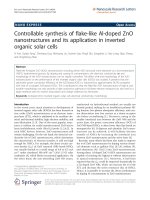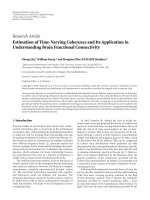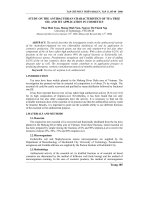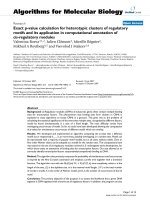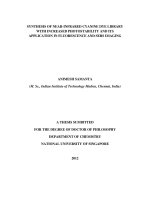Theoretical backgrounds of metaphor and practically is its application in teaching language
Bạn đang xem bản rút gọn của tài liệu. Xem và tải ngay bản đầy đủ của tài liệu tại đây (86.71 KB, 13 trang )
0
MAI TUYET NHUNG_K18C
TABLE OF CONTENTS
1. INTRODUCTION……………………………………………………….1
2. DEVELOPMENT………………………………………………………..1
2.1. What is metaphor?.................................................................................1
2.2. Features of metaphor………………………………………………….3
2.2.1.
Conventionality……………………………………………………….3
2.2.2. Systematicity………………………………………………………….3
2.2.3. Asymmetry……………………………………………………………3
2.3. The role of metaphor………………………………………………….4
2.4. Functions of metaphors……………………………………………….5
2.4.1. Naming function……………………………………………………..5
2.4.2. Cognitive function……………………………………………………5
2.4.3. Symbolic function……………………………………………………5
2.5. Types of metaphors……………………………………………………6
2.5.1. Living metaphors…………………………………………………….6
2.5.2. Faded metaphors…………………………………………………….6
2.5.3. Dead metaphors …………………………………………………….6
2.6. The transference………………………………………………………7
2.6.1. The names of the parts of human body……………………………..7
2.6.2. The names of animals ……………………………………………….7
2.6.3. Proper names…………………………………………………………7
2.7. Implications for teaching language…………………………………..8
2.7.1. Increasing student vocabulary………………………………………8
2.7.2. Activities in classroom………………………………………………9
2.7.3. Using English creatively……………………………………………10
FINAL ASSIGNMENT_SEMANTICS
1
MAI TUYET NHUNG_K18C
2.7.4. Developing student autonomy………………………………………
10
3. CONCLUSION…………………………………………………………11
4. REFERENCES…………………………………………………………12
1. INTRODUCTION
In the language, concepts are not isolated from each other; their
association makes up a huge network; for example, words with
identical or very similar meanings create synonyms, words that lie in an
inherently incompatible binary relationship as in the opposite pairs
refer to opposites or antonyms, the relation in which words stand when
their extensions stand in the relation of class to subclass is hyponym,
we also have the figures involving the substitution of one term for
another but
in metaphor, this substitution is based on similarity,
whereas, in metonymy, the substitution is based on contiguity, etc….
Hence, objects are called out and human thoughts are expressed. All of these
belong to semantic. In the limitation of time, I only want to focus on
metaphor to my interest in the literary or poetic language. Through the
process of study, I understand that metaphor is not only the language of
literature but also of everyday communication. It is indeed worldwide so as
to convey people’s ideas, feeling, emotion or attitude instead of using the
direct way, in other words, metaphor is a good example of the association of
one concept in terms of another based on similarity.
This study is intended to review all the theoretical backgrounds of metaphor
and practically is its application in teaching language.
2. DEVELOPMENT
2.1. What is metaphor?
FINAL ASSIGNMENT_SEMANTICS
MAI TUYET NHUNG_K18C
2
It’s the definition of metaphor which makes the learners have an insight into
metaphor in general. There are many ways to identify metaphor by denoting
it, but the followings are the trustworthy sources.
According to the linguistic point of view, “metaphor is an extension in the
use of the word beyond its primary meaning to describe referents that bear
similarities to the word’s primary referent”.(Language-its structure and
use, 1994).
In addition, to cognitive viewpoint, Barcelona said that “Metaphor is the
cognitive mechanism whereby one experiential domain is partially mapped
or projected onto a different experiential domain so that the second domain
is partially understood in terms of the first one”.
Given by Oxford Advanced Learner’s Dictionary, metaphor is defined as the
imaginary use of a word or a phrase to describe somebody/something as
another object in order to show that they have the same qualities and as to
make the description more forceful.
The term metaphor is also clearly mentioned in the textbook. Metaphor that
comes from Greek means “transference”. Therefore, metaphor is word
meaning transference based on similarity between two things as regards
function, character, size, shape, age, colour, etc…
All the above definitions show the using metaphor in the transference of
meaning, extension of meaning and conveying imagination is to
communicate more persuasively and effectively. Although metaphor is
viewed from different angles, the common thing is that metaphor is the way
we call one object in terms of another thanks to comparison and finding
some common features between these objects. Take this example:
Mary is a fox. I love her.
In this example, the word “fox” has a positive meaning because fox is
considered to be a cute little animal; therefore, the term is used to describe a
FINAL ASSIGNMENT_SEMANTICS
MAI TUYET NHUNG_K18C
3
woman thought as of beautiful, attractive, and sexy. Clearly, the similarity in
this case between an animal “a fox” and a person “Mary” is based on the
character. However, in another situation, fox maybe has a negative meaning:
for example, a cunning person is commonly referred to as a fox “Mary is a
fox. I hate her”. That’s the transference of meaning- Metaphor and we can
liken something to something else on certain grounds.
2.2. Features of metaphor
2.2.1. Conventionality
The first, conventionality raises the issue of the novelty of the metaphor. The
original sentence meaning is bypassed and the sentence acquires a new
literal meaning identical with the former metaphorical meaning. This is a
shift from the metaphorical utterance… to the literal utterance. For instance,
“Movie studio love a good fight, and a bad one too. But the Oscar battles
have become trench warfare and dirty tricks” (From reports on the 2002
Hollywood film awards). The awards competition here is portrayed in terms
of warfare. Apparently, metaphor has passed into literal language which the
speaker isn’t adding rhetorical or poetical flourishes to his language.
2.2.2. Systematicity
The second feature, systematicity, refers to the way that a metaphor does not
just set up a single point of comparison: features of the source and target
domain are joined so that the metaphor may be extended, or have its own
internal logic. We can take an example from a Science magazine article
about the sun, where the development of suns is metaphorically viewed as
children growing up: “A nursery of unruly stars in the Orion Nebula has
yielded the best look at our sun’s baby album…”
2.2.3. Asymmetry
Our third feature, asymmetry refers to the way that metaphors are
directional. They don’t set up a systematrical comparison between two
FINAL ASSIGNMENT_SEMANTICS
4
MAI TUYET NHUNG_K18C
concepts, establishing points of similarity. Instead they provoke the listener
to transfer features from the source to the target. We can take the metaphor
LIFE IS A JOURNEY as an example: this metaphor is asymmetrical and the
mapping does not work the other way around. We don not conventionally
describe journeys in terms of like, so that it sounds odd to say Our flight was
bourn(i.e. arrived) a few minutes early or By the time we got there, the boat
had died (i.e. gone). Even if we are able to set up such a metaphor, it is clear
that the meaning would be different from that of the original structure.
The last feature, abstraction, is related to this asymmetry. It has often been
noted that a typical metaphor uses a more concrete source to describe a more
abstract target. Again the LIFE IS A JOURNEY metaphor exhibits this
feature: the common, everyday experience of physically moving about the
earth is used to characterized the mysterious processes of birth and death,
and the perhaps equally mysterious processes of ageing, organizing a career,
etc. this is not a necessary feature of metaphors: the source and target may
be equally concrete or abstract, but as we shall see, this typical viewing of
the abstract through the concrete is seen in cognitive semantics as allowing
metaphor its central role in the categorizing of new concepts, and in the
organization of experience.
2.3. The role of metaphor
There are two traditional views on the role of metaphor in language. The
first one, classical view sees metaphor as a kind of decorative addition to
ordinary plain language; a rhetorical device to be used at certain times to
gain certain effects. This view portrays metaphor as something outside
normal language and which requires special forms of interpretation from
listeners or readers.
The second traditional approach to metaphor is Romantic view. In this view,
metaphor is integral to language and thought as a way of experiencing the
FINAL ASSIGNMENT_SEMANTICS
5
MAI TUYET NHUNG_K18C
world. It is evidence of the role of the imagination in conceptualizing and
reasoning and it follows that all language is metaphorical. In particular, there
is no distinction between literal and figurative language.
An important characteristic of cognitive semantics is the central role in
thought and language assigned to metaphor. Given the classical/ Romantic
opposition we have describe, the cognitive semantics approach can be seen
as an extension of the Romantic view.
2.4. Functions of metaphors
According to Dinh Trong Lac (1994:53), a Vietnamese linguist, there are
three basic functions of metaphors called naming, cognitive and symbolic
functions.
2.4.1. Naming function
Metaphor is only intended to give names to things based on the experience
with the existing vocabulary. This metaphor has no or very little rhetoric
value but it can reflect the way in which things in the world are viewed
together. For example, the lowest part of the mountain is called the foot of
the mountain as the foot on the human body is the lowest part.
2.4.2. Cognitive function
This metaphor doesn’t give new names to things but conceptualizes them in
terms of another. It is also conventional and of little rhetoric effect. For
instance, the word “sunny” has positive connotation and it is transferred to
talk about the mood of people happy and optimistic because when it is
sunny, the sun is shining and brings pleasant weather that can make people
happy and comfortable.
2.4.3. Symbolic function
Metaphor reflects the imaginative and creative way individuals judge and
comment things, which can make the language more expressive and more
persuasive. It is very popular in poetic language and thought to be the
FINAL ASSIGNMENT_SEMANTICS
MAI TUYET NHUNG_K18C
6
conventional function of metaphor. For example, flowers often symbolize
for the beauty, hence, they are often compared with women’s beauty.
2.5. Types of metaphors
Metaphors can be classified into three main types based on the degree of
unexpectedness according to Mr Nguyen Hoa (2004:109) such as: living
metaphors, faded metaphors and dead metaphors.
2.5.1. Living metaphors
In these metaphors, the word is used in unusual meaning and metaphors are
poetic and created by individuals, which are unexpected and unpredictable.
e.g. Peace is a fortress
We can see that fortress is a fortified defensive structure for the life, so
something considered to be a fortress is necessary to be protected and
reserved. With this symbolic function, living metaphors are also called
creative or poetic metaphors, they are commonly used in literature and
poetry, not in everyday language use.
2.5.2. Faded metaphors
Faded metaphor or trite metaphor is which lost its freshness because of long
use and became habitual. For example, in the way of saying “golden youth”
is to imply that the youth is a valuable period as gold. This expression is so
popular in daily communication that it is sometimes recognized not to be
metaphor.
2.5.3. Dead metaphors
Dead metaphors are words which have lost their direct meaning and are used
only figuratively, in other words, metaphoric sense is not felt. To ponder, for
instance, originally meant “to weigh”, but it is used now only in the meaning
“to meditate, to consider thoughtfully”.
2.6. The transference
FINAL ASSIGNMENT_SEMANTICS
MAI TUYET NHUNG_K18C
7
2.6.1. The names of the parts of human body are transferred to other
objects
It is clear that people first of all knew their own body and gave names to its
parts. Later in the process of cognition of the world they began comparing
the surrounding objects with their own body and finding common features.
That is why parts of our body are used as metaphors.
For example, metaphor relating to “head” has many meanings. First, head is
the first, highest and foremost part of all in comparison with the other parts;
therefore, the first referent is the first and more important part of a place or
thing. We have “head of the page, head of the stair. Head of the bed, head of
the table. Head of the train, head of the lake, head of the river, head of the
valley, head of the village, head of the queue…”.Additionally, the word
“head” is also used to refer to the abstract thing that is at the highest position
in a system or a class like this example: “Tom is at the head of his
profession”.
Moreover, other parts of body are also used widely such as face of the
diamond, eye of the potato, nose of a plane, ear of a cup, teeth of the comb,
tongue of flame, shoulder of the bottle, hand of the clock, arm of a chair,
back of a house, body of the plane, leg of a lamp, foot of the mountain, heart
of the country, skeleton of the building, etc…
2.6.2. The names of animals are also often transferred to the human
beings.
If two objects or phenomena are compared and common features are found
we speak of metaphor. In the world of animals, we can see a lot of the same
characteristics as human beings. a cunning person is a fox, a spiteful person
is a snake, a rude person is a bear, a hard working person is a bee, or a
beaver. There are many expressions based on names of animals (bird’s view,
crocodile tears).
FINAL ASSIGNMENT_SEMANTICS
MAI TUYET NHUNG_K18C
8
2.6.3. Proper names are transferred to common ones
Another subgroup of metaphors comprises proper names transferred to
common ones. For instance, a jealous person is called an Othello (Othello, a
character in Shakespeare's Othello (c.1601-1604) killed his wife out of
jealousy) and an eloquent speaker is a Cicero (Marcus Tullius Cicero was a
Roman philosopher, statesman, lawyer, political theorist, and Roman
constitutionalist. He came from a wealthy municipal family of the equestrian
order, and is widely considered one of Rome's greatest orators and prose
stylists).
2.7. Implications for teaching language
2.7.1. Increasing student vocabulary
Being a teacher of English, I can see that teaching metaphor is very
important to students and understanding metaphor can help students enrich
their vocabulary so as to make their communication more persuasive and
effective.
Metaphors provide a handy and memorable way of organising new
vocabulary to be learned. Most teachers are familiar with the notion of a
lexical set, where vocabulary is grouped according to a topic area, such as
'food' or 'transport'. This idea can be extended to create 'metaphorical sets',
where we group together the words and expressions that have a
metaphorical, rather than a literal, meaning. Here are some examples:
Body vocabulary
Weather vocabulary
Colour vocabulary
the heart of the city
a warm welcome
to see red
the to freeze somebody out
a grey area
mountain/bed/stairs
to be snowed under
a white lie
to give a hand
to storm out
to give somebody the
the
to
foot
break
of
somebody's a hail of abuse
green light.
heart
FINAL ASSIGNMENT_SEMANTICS
MAI TUYET NHUNG_K18C
9
2.7.2. Activities in classroom
In the classroom, there are different ways we can incorporate this idea of
metaphorical sets. One way is to ask students in groups to research and
design a poster related to a particular topic. Take the body, for example.
Students could be asked to draw an outline of a human body on a large sheet
of paper, and to include a heart, feet, hand, eye, nose, etc. Using English
dictionaries, they could then research any metaphorical uses of language
connected with the different parts of the body and write them in the
appropriate place on the poster. The same activity can be done for weather
vocabulary (using little sketches of different types of weather) or for colours
(using sheets of paper of different colours).
Another way is to ask students to brainstorm the words in a particular lexical
area, such as plants. They may come up with words such as: roots, branches,
seed, to blossom, to bloom, to plant.
Once you have checked that students have understood the literal meaning of
all the words involved, ask them to guess what the metaphorical meaning of
these words might be. And once you have established the metaphorical
meanings for these words (such as the roots of a problem or to plant an idea
in somebody's mind) ask students to write a story using as many of these
words as they can.
I find the stories are always very inventive, and reveal the real pleasure that
students take in using another language creatively!
2.7.3. Using English creatively
As we have seen, many metaphors in English form part of the ordinary
repertoire of the native speaker. We can help students to learn some of these
fixed metaphors while simultaneously encouraging them to play creatively
with language.
FINAL ASSIGNMENT_SEMANTICS
10
MAI TUYET NHUNG_K18C
One way is to ask students to write short poems with one of the following
titles: WEATHER METAPHORS
A sunny smile
An icy look
A stormy relationship
People metaphors
A chip off the old block
A rough diamond
A shoulder to cry on
An ugly duckling
A fairy godmother
Parts of proverbs
A new broom
Early birds
Birds of a feather
Silver linings
A rolling stone
2.7.4. Developing student autonomy
Finally, we can develop students' awareness of metaphors by encouraging
students to 'collect' metaphors - by noting them down when they encounter
them on the Internet, in pop songs, etc. These metaphors can then be
explained and discussed in the classroom. You may even want to keep a
record of these on a wall poster….and at the end of the term ask students to
vote on the most useful metaphor, the most surprising metaphor, their
favourite metaphor, etc.!
FINAL ASSIGNMENT_SEMANTICS
11
MAI TUYET NHUNG_K18C
3. CONCLUSION
To sum up, the study provides a systematic and clear view on metaphor in
theory and its applications in teaching language in practice. In general, both
theoretically and experimentally, the approach to metaphor has been applied
not only to the study of grammar and semantics, but also to historical
linguistic, categories of thought, poetic language, rhetoric and ethics. In my
discussion, I concentrate on semantic issues and I see the role of metaphor in
language. It’s not so strange, vice versa; it is one kind of personification
because everything in the world is not viewed in isolation but in the
association with human beings. That is, things in the world are always seen
in the associative eye of the human beings. So metaphor is familiar and
understandable to ordinal people.
It is hoped that this study on basic metaphor , to some extent, helps readers
not only acquire this interesting and popular use of words, which sis helpful
to them in language but also motivate them their further language study.
FINAL ASSIGNMENT_SEMANTICS
12
MAI TUYET NHUNG_K18C
REFERENCES
1. Nguyen Hoa (2004). Understanding English semantics. Nha xuat ban
Dai hoc Quoc gia Ha noi.
2. Nguyen Thi Yen Thoa (2005). A contrastive analysis of metaphors
relating to parts of human body in English and Vietnamese. Vietnam
National University, the college of Foreign Languages.
3. René Driven Ralf Porings (2003). Metaphor and Metonymy in
comparison and contrast. Mouton de Berlin- New York.
4. John I. Saeed (2003). Semantics. Blackwell Publishing.
5. />hor.htm
6. />7. />8. />
FINAL ASSIGNMENT_SEMANTICS





